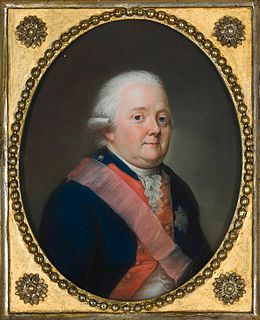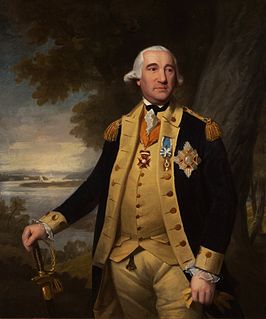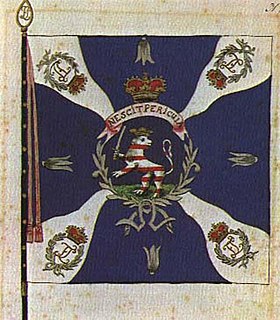
Freiherr Friedrich Adolf Riedesel Freiherr zu Eisenbach was a German officer who served in the Seven Years' War and American War of Independence. He was the commander of the Braunschweiger Jäger, a regiment of soldiers from the Principality of Brunswick-Wolfenbüttel that was among the German units hired by the British during the American War of Independence. He then commanded all German soldiers in the Saratoga Campaign.

Hessians were German soldiers who served as auxiliaries to the British Army during the American Revolutionary War. The term is an American synecdoche for all Germans who fought on the British side, since 65% came from the German states of Hesse-Kassel and Hesse-Hanau. Known for their discipline and martial prowess, around 30,000 Germans fought for the British during the war, comprising a quarter of British land forces.

Wilhelm Reichsfreiherr von Innhausen und Knyphausen was a German general officer who served in Hesse-Kassel. He fought in the American Revolutionary War, during which he commanded Hessian auxiliaries on behalf of Great Britain.
Hesse-Hanau was a territory in the Holy Roman Empire. It emerged when the former county of Hanau-Münzenberg became a secundogeniture of Hesse-Cassel in 1760. When the reigning count, William IX, also became landgrave of Hesse-Cassel in 1785, the two governments began to merge, although the process was delayed first by French occupation, and later by incorporation into the French satellite duchy of Frankfurt. The incorporation of Hesse-Hanau with Hesse-Cassel was not completed until 1821.

The 1st Rhode Island Regiment was a regiment in the Continental Army raised in Rhode Island during the American Revolutionary War (1775–83). It was one of the few units in the Continental Army to serve through the entire war, from the siege of Boston to the disbanding of the Continental Army on November 3, 1783.
The 56th Infantry Division was a division of the Imperial German Army. It was formed during World War I and dissolved with the demobilization of the German Army in 1919.
The 25th Division, officially the Grand Ducal Hessian (25th) Division, was a unit of the Prussian/German Army. It was headquartered in Darmstadt, the capital of the Grand Duchy of Hesse. The division was subordinated in peacetime to XVIII Army Corps when that corps was formed in 1899. The division was disbanded in 1919, during the demobilization of the German Army after World War I.
The Northern theater of the American Revolutionary War also known as the Northern Department of the Continental Army was a theater of operations during the American Revolutionary War.

Ethnic Germans served on both sides of the American Revolutionary War. Large numbers of Germans had emigrated to Pennsylvania, New York and other American colonies, and they were generally neutral or supported the Patriot cause. Some belonged to pacifist sects such as the Amish, but many were drawn into the Revolution and the war.

Regiment Von Trümbach was a regiment from the Landgraviate of Hesse-Kassel that fought alongside Britain in the American Revolution. It became Second Battalion, Regiments Prinz Carl von Hessen in 1789; Second Battlion, 3rd Hessian Infantry Regiment in 1821; and was known as First Battalion, 3. Hessian Infantry Regiment Nr. 83 of the Prussian Army from 1866. From 1889 it was part of Infanterie-Regiment von Wittich Nr. 83.
Creuzbourg's Jäger Corps(Jäger-Corps von Creuzbourg) was an independent Jäger battalion raised by the county of Hesse-Hanau and put to the disposition of the British Crown, as part of the German Allied contingent during the American Revolutionary War. The corps fought at the Battle of Oriskany, although mostly serving as garrison of different Canadian posts.

Hesse-Hanau Troops in the American Revolutionary War served as auxiliaries to the British Army during the American Revolutionary War, in accordance with the treaty of 1776 between Great Britain and the small principality of Hesse-Hanau. One regiment of foot, one artillery company, one ranger corps, and one light infantry corps served in British America. A total of 2,422 soldiers were sent, and 1,441 returned, the remainder either not surviving or choosing to remain in America. As compensation the reigning count of Hesse-Hanau received a total of 343,110 pound sterling from the British government.

Brunswick Troops in the American Revolutionary War served as auxiliaries to the British Army during the American Revolutionary War, in accordance with the treaty of 1776 between Great Britain and the Principality of Brunswick-Wolfenbüttel. Four regiments of foot, one regiment of dragoons, one grenadier battalion, and one light battalion with a Jäger company were dispatched to British America. Most of the Brunswick troops fought at the Battles of Saratoga, where they were forced to surrender as part of British General John Burgoyne's army. A total of 5,723 soldiers were sent overseas, and 2,708 returned to Brunswick-Wolfenbüttel. Part of the difference can be attributed to casualties, but the rest chose to remain in the United States or Canada instead of returning to Europe. Over the course of the war, the British government paid the Prince of Brunswick-Wolfenbüttel a total of £750,000 for the use of his army.

The Province of Nova Scotia was heavily involved in the American Revolutionary War (1776–1783). At that time, Nova Scotia also included present-day New Brunswick until that colony was created in 1784. The Revolution had a significant impact on shaping Nova Scotia, "almost the 14th American Colony". At the beginning, there was ambivalence in Nova Scotia over whether the colony should join the Americans in the war against Britain. Largely as a result of American privateer raids on Nova Scotia villages, as the war continued, the population of Nova Scotia solidified their support for the British. Nova Scotians were also influenced to remain loyal to Britain by the presence of British military units, judicial prosecution by the Nova Scotia Governors and the efforts of Reverend Henry Alline.

Friedrich Wilhelm von Lossberg was a Hessian Lieutenant General fighting with the British-allied German contingents in the American Revolutionary War. He was sent to America in 1776 as a colonel commanding the First Brigade of the Second Hessian Division under Lieutenant General Wilhelm von Knyphausen. Von Knyphausen in turn was second in command under General Leopold Philip de Heister.
Graf Heinrich Julius von Kospoth was a Hessian Major General who served in the American Revolutionary War. He was first Colonel of the Musketeer Regiment Wutgenau and later as a Major General, commanded the First Hessian Division; consisting of the regiments Knyphausen, Ditfurth, Prince Frederick, Bose, Borbeck, Bunau, Benning and Knobloch as well as the Grenadier Battalion Angenelli.

Prince Heinrich Ludwig Wilhelm Adalbert Waldemar Alexander of Hesse and by Rhine was a member of the House of Hesse-Darmstadt and a General of the Cavalry.

Hesse-Hanau Regiment Erbprinz(Infanterie-Regiment „Erbprinz“ ) was an infantry regiments raised by Hesse-Hanau and put to the disposition of the British Crown, as part of the German Allied contingent during the American Revolutionary War. It was organized in one grenadier and five regimental companies and was commanded by Colonel Wilhelm Rudolf von Gall. The regiment participated in the siege of Ticonderoga 1777, the battle of Freeman's Farm 1777 and the battle of Bemis Heights 1777. It surrendered at Saratoga with the rest of the troops under Burgoyne.












